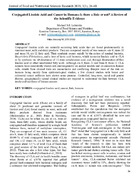| dc.description.abstract | Conjugated linoleic acids are naturally occurring fatty acids that are found predominantly in ruminant meat, milk and dairy products. They are composed mainly of two isomers: cis-9, trans-11 and trans-10, cis-12 fatty acid. Their synthesis occurs mainly by the action of ruminal bacteria, Butyrivibrio Fibrisolvens, and a host of lactic acid bacteria, which isomerize linoleic acid to CLA or by synthesis via α9-desaturase of 11-trans octadecanoic acid, and, through desaturation of free linoleic acid or other unsaturated fatty acids. Although cis-9, trans-11 and trans-9, trans-11 CLA isomers have consistently shown anti-carcinogenicity on animal models and on cancerous human cells, results from clinical trials are inconclusive and conflicting. Despite most of the data on humans being mainly from epidemiological studies, a few clinical studies with breast and colorectal cancer sufferers have shown some promise. Controlled, long-term, racial and gender diverse, geographically spread clinical studies are required to understand the link between CLA intake and incidence of human cancers. | en_US |
